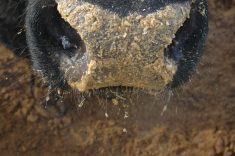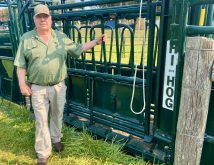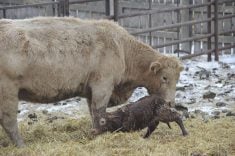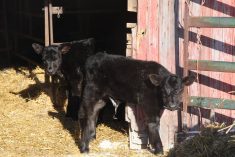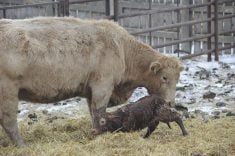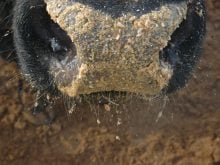Calves positioned backward at birth are unlikely to survive without assistance.
Often they suffocate because their heads are inside the cow when the umbilical cord pinches off or breaks.
Breech presentation is a different problem but also dangerous to calf survival.
A backward presentation is considered normal because the calf can be born even if it doesn’t survive. If the hind legs don’t enter the birth canal, however, the calf is breech and cannot be born. It will die unless the hind legs can be repositioned and brought into the birth canal.
If backward or breech presentation is recognized and dealt with early, there’s a good chance to save the calf.
Dr. Cec Ruschkowski of Oyen Vet Services in Oyen, Alta, says its challenging to birth backward or breech calves without injury.
“The force involved in pulling the calf may result in stifle injuries or broken legs or ribs. There is generally inadequate cervical dilation with a backward calf, which results in a hard pull,” she says.
Nature is programmed for frontward delivery, stretching the cow’s cervix and vulva gradually as the front legs and head come through, followed by shoulders and hips. When the hind legs come first, there is less stretch and the calf’s ribcage may catch on the cow’s pelvis.
Ruschkowski recommends using lots of lubricant when pulling a backward calf, putting it as far into the birth canal as possible alongside the calf. It may take the cow longer in early labour to get the long hind legs aimed in the right direction.
Before assuming the calf is backward, she suggests reaching into the birth canal to feel the whole leg. If there are hocks, the hind legs are coming first. A calf will sometimes be upside down or sideways, and when the feet first appear, they point upward.

Know which legs are presented before applying chains and starting to pull.
Ruschkowski advises producers to take time, with a backward presentation, to allow the cow’s cervix to stretch. If the rear end doesn’t come through readily, stop before injuring the calf.
“If you’ve had experience delivering backward calves, you’ll know when to quit, and not try to exceed your capabilities,” says Ruschkowski. “With a frontward calf, you can stop and push it back before the calf is in jeopardy (and have it delivered by C-section), but once you start on a backward calf, you are committed.”
Once the hindquarters are through the cow’s pelvis, pull hard and fast to extract the calf quickly so it can draw breath once the umbilical cord has broken.
“So pull slowly at first, to let the cow dilate, and make sure you will be able to get the calf out without a super-difficult pull, and then go for it to get the calf out quickly.”
When a calf’s hind legs don’t straighten in early labour and don’t enter the birth canal, the cow won’t begin hard straining so producers may wait too long to check. Eventually the placenta will detach, leading to calf distress and death.

“With a breech calf you have to recognize that the cow has been in early labour too long and has a problem. The producers who recognize it soon enough and bring the cow in quick enough for us to deliver a live calf get a pat on the back from us. They are good herdsmen and they know when a cow is in trouble,” says Ruschkowski.
“If you are not experienced at correcting a breech presentation, you shouldn’t try. This takes experience, and long arms. If you realize this is the situation, don’t break the water bag if you are incapable of correcting this yourself,” Ruschkowski says.
Once the water bag is broken, the clock is ticking. If the calf is breech, the rump must be pushed forward so it’s not jammed against the cervix and there is room to grasp and maneuver each hind leg into the birth canal.

This will be easier if the cow is standing so it can’t push as hard against the person assisting. It is also easier to get both arms into the birth canal.
Reaching inside is the best way to reposition a breech calf. A calf coming through this space is wider than two arms.
The calf must be pushed back as far as possible so its legs can be properly positioned. Once both are extended and in the birth canal, attach chains and pull the calf using lots of lubricant and give the cow time to dilate.
If it is impossible to manoevre the legs, call the veterinarian or someone with more experience. Even then, a C-section may be required.





